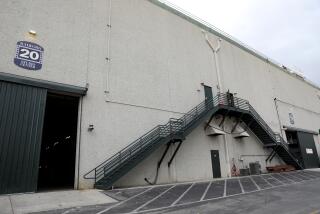Air Force Blames Contractor in Fatal Rocket Accident
- Share via
In the months before a fatal crane accident at Edwards Air Force Base last year, a private contractor declined several times to implement critical safety recommendations from the crane operator because they were too expensive, Air Force investigators have found.
The failure of the contractor, Hercules Inc. of Utah, to realize that the giant crane was operating on a hazardous surface was among the factors contributing to the Sept. 7 accident, according to an Air Force report.
The report was obtained by The Times on Tuesday under the Freedom of Information Act.
“The site operating contractor (Hercules) did not have the necessary mobile crane expertise” but “refused to implement recommendations from the crane subcontractor,” the report said. “Decisions were based only on cost, as many opportunities had passed to properly prepare, or repair, the working surface of the crane.”
A Hercules spokesman had no comment Tuesday on the report.
One laborer was killed by falling weights used to balance the 900-ton crane and nine other workers were injured when the crane broke through a plywood-and-gravel operating surface and collapsed, dropping a Titan 4 rocket motor that erupted in a flash fire at the outdoor test site.
The rocket motor segment, loaded with about 270,000 pounds of solid fuel, ignited after hitting a desert ridge and sliding about 70 feet downhill into a concrete fire containment basin. The flash fire sent a mushroom-shaped cloud billowing thousands of feet in the air and forced an evacuation of the rocket test laboratory.
The blaze burned itself out almost immediately. Other than the fatality, injuries were generally minor to the laborers and crane operators who ran for safety as the 400-foot crane collapsed.
Cal/OSHA fined Hercules, crane operator Lampson Inc., and Wyle Laboratories, a labor subcontractor, about $10,000 each in February for safety violations, which included allowing employees to work in an unsafe environment, overloading the crane and failing to provide adequate emergency planning.
Hercules has paid the fine, a Cal/OSHA spokesman said, but Lampson and Wyle have appealed.
In addition, Hercules and Lampson have already paid a $2.4-million settlement to the widow and daughter of 27-year-old Alan Quimby of Lancaster, who was killed in the accident.
Air Force officials said Tuesday that new safety measures have been taken at the Edwards test site, but would not comment on whether any action will be taken against Hercules or the other contractors in light of the report’s conclusions. Another Titan 4 rocket motor blew up during its test firing in April.
The Air Force findings are similar to the results of the Cal/OSHA investigation, but include more detail on alleged safety problems leading up to the accident, as well as some new information.
For example, Air Force investigators found that as the crane brought the rocket motor to an outdoor storage stand, an overworked supervisor failed to monitor whether the crane remained level during a critical 54-second period before the accident. A tank-like crane tread then moved off a plywood pad and sank into a bed of “pea gravel” used to correct an uneven concrete surface beneath the crane, according to Cal/OSHA and the Air Force.
“The supervisor was overloaded with critical tasks,” the Air Force report said. “The level should have been monitored continuosly.”
As in the Cal/OSHA findings, Air Force investigators found that Hercules used a less expensive plywood and gravel surface beneath the crane, rather than solid oak slabs recommended by Lampson. Unlike the Cal/OSHA findings, the Air Force report makes it clear that Hercules made that decision to save money and turned down requests, dating back to March, 1989, made by crane operators for the timber mats.
Mark Carleson, deputy director of Cal/OSHA, said he had not seen the Air Force report but said it would be reviewed. He said the findings appeared to differ from Cal/OSHA’s findings in the amount of detail and critical language employed, not in substance.
“We felt our citations were appropriate and, at least in our scheme of things, relatively hefty,” he said. “We stand by our original investigation.”
Cal/OSHA cited the subcontractors for violations that were classified as “serious,” but not “willful.” It found that the employers did not intentionally choose unsafe procedures but were deficient in engineering and in planning the operation.
The Air Force investigators also found that overall management, safety precautions and employee training in crane operation were poor, even after a mishap in June when the motor scraped the roof of a building as it was being transported by the crane.
“The management of this operation, even after the June mishap, was not given the attention required to ensure safe operations,” the Air Force report said.
More to Read
Sign up for Essential California
The most important California stories and recommendations in your inbox every morning.
You may occasionally receive promotional content from the Los Angeles Times.













